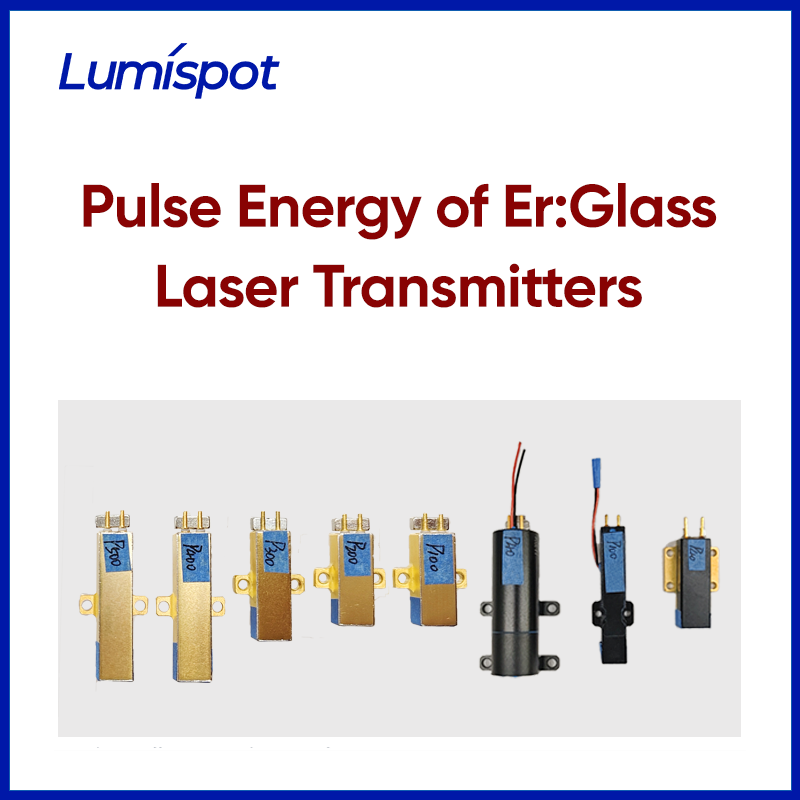In the fields of laser ranging, target designation, and LiDAR, Er:Glass laser transmitters have become widely used mid-infrared solid-state lasers due to their excellent eye safety and compact design. Among their performance parameters, pulse energy plays a crucial role in determining detection capability, range coverage, and overall system responsiveness. This article offers an in-depth analysis of the pulse energy of Er:Glass laser transmitters.
1. What Is Pulse Energy?
Pulse energy refers to the amount of energy emitted by the laser in each pulse, typically measured in millijoules (mJ). It is the product of peak power and pulse duration: E = Ppeak×τ. Where: E is the pulse energy, Ppeak is the peak power, τ is the pulse width.
For typical Er:Glass lasers operating at 1535 nm—a wavelength in the Class 1 eye-safe band—high pulse energy can be achieved while maintaining safety, making them especially suitable for portable and outdoor applications.
2. Pulse Energy Range of Er:Glass Lasers
Depending on design, pump method, and intended application, commercial Er:Glass laser transmitters offer single-pulse energy ranging from tens of microjoules (μJ) to several tens of millijoules (mJ).
Generally, Er:Glass laser transmitters used in miniature ranging modules have a pulse energy range of 0.1 to 1 mJ. For long-range target designators, 5 to 20 mJ is typically required, while military or industrial-grade systems may exceed 30 mJ, often utilizing dual-rod or multi-stage amplification structures to achieve higher output.
Higher pulse energy generally results in better detection performance, especially under challenging conditions such as weak return signals or environmental interference at long ranges.
3. Factors Affecting Pulse Energy
① Pump Source Performance
Er:Glass lasers are typically pumped by laser diodes (LDs) or flashlamps. LDs offer higher efficiency and compactness but demand precise thermal and driving circuit control.
② Doping Concentration and Rod Length
Different host materials like Er:YSGG or Er:Yb:Glass vary in their doping levels and gain lengths, directly impacting energy storage capacity.
③ Q-Switching Technology
Passive Q-switching (e.g., with Cr:YAG crystals) simplifies the structure but offers limited control accuracy. Active Q-switching (e.g., with Pockels cells) provides higher stability and energy control.
④ Thermal Management
At high pulse energies, effective heat dissipation from the laser rod and device structure is essential to ensure output stability and longevity.
4. Matching Pulse Energy to Application Scenarios
Choosing the right Er:Glass laser transmitter depends heavily on the intended application. Below are some common use cases and corresponding pulse energy recommendations:
① Handheld Laser Rangefinders
Features: compact, low power, high-frequency short-range measurements
Recommended Pulse Energy: 0.5–1 mJ
② UAV Ranging / Obstacle Avoidance
Features: mid-to-long range, fast response, lightweight
Recommended Pulse Energy: 1–5 mJ
③ Military Target Designators
Features: high penetration, strong anti-interference, long-range strike guidance
Recommended Pulse Energy: 10–30 mJ
④ LiDAR Systems
Features: high repetition rate, scanning or point cloud generation
Recommended Pulse Energy: 0.1–10 mJ
5. Future Trends: High Energy & Compact Packaging
With ongoing advancements in glass doping technology, pump structures, and thermal materials, Er:Glass laser transmitters are evolving toward the combination of high energy, high repetition rate, and miniaturization. For example, systems integrating multi-stage amplification with actively Q-switched designs can now deliver over 30 mJ per pulse while maintaining a compact form factor—ideal for long-range measurement and high-reliability defense applications.
6. Conclusion
Pulse energy is a key performance indicator for evaluating and selecting Er:Glass laser transmitters based on application requirements. As laser technologies continue to evolve, users can achieve higher energy output and greater range in smaller, more power-efficient devices. For systems demanding long-range performance, eye safety, and operational reliability, understanding and selecting the proper pulse energy range is crucial for maximizing system efficiency and value.
If you’re looking for high-performance Er:Glass laser transmitters, feel free to contact us. We offer a variety of models with pulse energy specifications ranging from 0.1 mJ to over 30 mJ, suitable for a wide range of applications in laser ranging, LiDAR, and target designation.
Post time: Jul-28-2025

